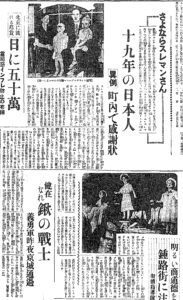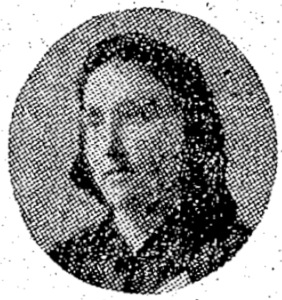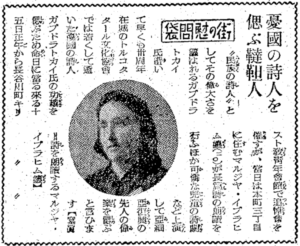At the beginning of the Pacific War in December 1941, there was apparently a small community of German residents working and living in Seoul, many with Nazi ideological leanings as demonstrated in this photo and article. Here are the four German residents featured in this article:
- Mrs. Weske and her child (featured in the accompanying photo with a Nazi flag)
- Mr. Budewell (44 years old), missionary
- Mr. Hupper (36 years old), lecturer at Keijo Imperial University
- Mrs. Rita Buchwald (30 years old), married to deceased Dr. Jeon
One interesting note is that Mrs. Rita Buchwald was married to a deceased Korean medical doctor by the name of Dr. Jeon. He is described by Mrs. Buchwald as "Japanese (日本人)", but that was not unusual in those times. To clarify that the "Japanese" person was ethnic Korean, she would have probably used the word 半島人 (literally, "peninsular person") or 朝鮮人 (literally, "Joseon person"). Unfortunately, the two Hanja of his first name are smudged and too hard to read on the scanned newspaper articles.
Another interesting observation is that Dr. Jeon and Mrs. Buchwald lived at 84 Gwanhun-dong in Jongno District, only a few house numbers away from the Lim family (address 90 Gwanhun-dong), which was prominently featured in a December 10, 1943 article proudly sending their son to be enlisted in the Imperial Army.
[Translation]
Gyeongseong Ilbo (Keijo Nippo) December 12, 1941
Emotion of Axis Nationals in Residence
Victory Already Certain
German Lady Ms. Weske Speaks
Living by the spirit of the Japan–Germany Axis—hands clasped firmly together—she has, under the skies of a foreign land, devoted herself to praying for the growth of her homeland Germany and wishing for the prosperity of Japan. When this reporter visited the home of the German lady Mrs. Weske at 70 Tongui-dong, Seoul, and brought her the joyful news of the Tripartite Pact between Japan, Germany, and Italy, Mrs. Weske was beside herself with delight, almost leaping for joy. Her blue eyes, shining behind her spectacles, burned with hope as she spoke animatedly. Though her Japanese was not fluent and could not fully carry her feelings, she expressed a joy too great to contain.
“Ever since before, I had wished for just such a deep and firm agreement. For someone like myself who lives in Japan, it brings a very real sense of certainty. And so long as I am German, this feeling is one that runs through the entire German people, a shared national feeling. When Japan and Germany, together with Italy, unite their young and surging energies, it seems to me inevitable that true peace will be brought to the world. The results Japan has achieved in the Pacific this time strike me as the victory of precisely that youthful spiritual power which must bring about such inevitability. I felt I understood this with complete clarity, more than anything else. It is curious, is it not? Just hearing that the pact has been concluded makes the people around one feel suddenly closer, as though they were compatriots.”
[Photograph: Mrs. Weske speaking emotionally together with her beloved child]
Now Comes the Final Hammer Blow
The Fiery Spirit of Professor Hupper of Keijo Imperial University
At a residence in 1-1 Yeonji-dong, Seoul, the German missionary Mr. Budewell (44), together with Mr. Hupper (36), a lecturer in the preparatory division of Keijo Imperial University, with whom he had been anxiously sharing concern for their homeland, spoke with mingled joy and deep emotion upon hearing the news that Germany, honoring its bond of trust with its ally Japan, had joined hands with Italy and firmly pledged itself to attack the U.S. and Britain.
“At last, it has been done. That is exactly how it should be. Anything else would be a lie. How could Germany possibly remain silent when our ally Japan has struck the U.S. and Britain with the hammer blow? The Nazi spirit would never permit it. From this point on, even if it means dying together, the peoples of Japan, Germany, and Italy must unite as one and fight through to the complete destruction of the U.S. and Britain. At that point, all the boasting of the U.S. and Britain will amount to nothing more than fragments of delusion. The Japanese Navy’s command of the Pacific on this occasion is the clearest possible proof. Let us raise a cheer for the brave officers and men of Japan and for the glorious German Army—banzai!”
Praying for Unending Military Fortune
Remarks by Mrs. Rita, Widow of the Late Medical Doctor Jeon
Raising the rallying cry of annihilating the enemies of humanity, Britain and America, in order to build a new world order, Germany and Italy, our allied powers, have finally risen to action. On the eleventh, the day of this robust advance, a German resident of Seoul, Mrs. Rita Buchwald (30), born in Berlin and widow of the late Dr. Jeon [illegible first name](전, 全) , a medical doctor, living at 84 Gwanhun-dong, spoke with emotion, her emerald-colored eyes shining, as she expressed gratitude for the great victories of our Imperial forces and took heart from Germany’s declaration of war against the United States.
“Following your country’s lead, my Germany and Italy have also declared war on the United States. I had been so restless, waiting and waiting for my homeland Germany to follow Japan and declare war on America. Now I feel relieved. Since strong Japan will strike down Britain and America, Germany’s victory is already clear. Japan and Germany together will fight bravely to build the happiness of a new world. I am the wife of a Japanese man. I take the greatest pride imaginable in having become the wife of a fine Japanese man. The joy of my homeland Germany joining hands with Japan to strike the U.S. and Britain is beyond words. I pray for the everlasting fortune of the Imperial forces.”
[Transcription]
京城日報 1941年12月12日
在留枢軸人の感激
勝利は既に確実
ドイツ系夫人ウさん語る
はっしと手を握り合った日獨枢軸の精神に生きて異国の空にひたすら故国ドイツの生長を祈り日本の繁栄を希っているドイツ系夫人ウヰスケーさんを京城通義町七〇の自宅に訪い日獨伊三国協定の快報を齎せば雀躍せんばかりに喜んだウヰスケーさんは眼鏡の底の碧眼を燃え出る希望に輝かしながら派手に語り得ない日本語をもどかし気に包み切れない喜びを語った。
『以前からそうした底深い協定が欲しいと思っていました。それは私のように日本に生活している者にとっては確固とした一つの実感でそしてこの実感は私がドイツ人である限り全ドイツに通じる民族の実感でありましょう。日本とドイツとそしてイタリー、この三国が若い沸り上る力を合せれば世界に真の平和を紊すことは必然だと私には想えます。日本がこの度放った太平洋での戦果はそうした必然をもたらすべき若き精神力の勝利だと私には想えるのです。そのことが私には何よりはっきりと判るのでした。不思議ですね。協定を結んだと聞いただけで周囲の人が同国人のようにぐっと近づいて感じられるのは』【写真=愛児と共に感激を語るウ夫人】
今ぞ最後の鉄槌
城大フ教授の気焰
城内蓮池町一ノ一宣教師ドイツ人ブデウェル氏(四四)万で祖国を案じ合っていた城大予科講師フッパー氏(三六)は祖国ドイツが盟邦日本との信義を重んじてイタリーと手を執り、米英爆撃の約束を固めた報に喜びながら感激を交々に語る。
『とうとうやりましたな。それでよいのです。そうこなくちゃ嘘ですよ。盟邦日本が米英に鉄槌を下したのになんでドイツが黙っていられましょうか?ナチス魂が断じて許しません。この上は死なば諸共日獨伊の国民が一丸となって米英覆滅を期して戦い抜くことです。そこには米英の豪語も一片の囈言にすぎなくなるでしょう。今回の日本海軍の太平洋制圧こそは最も如実な証拠です。日本の勇敢なる将兵と栄あるドイツ軍のため万歳をやりましょうー』
祈る武運長久
故全医博夫人
リータさん談
世界新秩序建設のため人類の敵米英を抹殺せんの合言葉を翳して盟邦獨伊も遂に起った。この逞しき進発の十一日、わが皇軍の大いなる戦果に感謝し獨の対米宣戦布告に勇を鼓して戦う在城ドイツ人寛勲町八四医博故全[illegible]氏未亡人ベルリン生れリータ・ブクバウルド女史(三〇)はエメラルド色の瞳を輝かせて感激を語る。
『お国の後を追ってわがドイツとイタリーも対米戦を宣告しました。私は早く祖国ドイツが日本に従って対米宣戦をしないものかと気が気でなりませんでした。これでほっとしました。強い日本が米英をやっつけて呉れる以上はドイツの勝利は明かですわ。日本とドイツは共に新しい世界の幸福を建設するため勇ましく闘うのです。私は日本人の妻です。立派な日本人の妻となったことをこの上なく誇りとするのです。故国ドイツが日本と手をとって米英を撃つ喜びは何とも言えません。皇軍の武運長久を祈ります。』
Sources:
- National Library of Korea, Digital Newspaper Archive
- Internet Archive, Keijo Nippo December 12, 1941

























